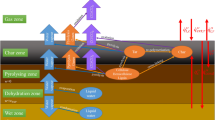Abstract
Building materials differ in their susceptibility to mould growth. Wood is a material often considered to have a low mould resistance. However, wood is not a homogenous material and different characteristics of the material are expected to have an impact on mould growth. In this paper, it was shown that wood species (pine or spruce), sawing pattern (centre-board or side-board) and surface structure (planed or sawn) affected mould growth. In addition, it was indicated that the susceptibility cannot be described by one single parameter, but also depends on other parameters. It is therefore difficult to estimate the susceptibility of wood in general. These conclusions were drawn from a meta-analysis, using data from five separate, previously performed laboratory studies conducted at 90% relative humidity and 22 °C, and from a laboratory study performed at 95% RH and 22 °C.





Similar content being viewed by others
References
Bewick V, Cheek L, Ball J (2004) Statistics review 12: survival analysis. Crit care 8(5):389–394
Blackburn C (2000) Modelling shelf-life. In: Kilcast D, Subramaniam P (eds) The stability and shelf-life of food. Woodhead Publishing Limited, Cambridge
EA-4/02M (2013) Expressions of the uncertainty of measurements in calibration. European Co-operation for Accreditation
Hyvärinen A, Meklin T, Vepsäläinen A, Nevalainen A (2002) Fungi and actinobacteria in moisture-damaged building materials—concentrations and diversity. Int Biodeterior Biodegrad 49:27–37
Johansson P (2012) Determination of the critical moisture level for mould growth on building materials. Doctoral thesis. Report TVBH-1020. Lund University
Johansson P (2014) Determination of the critical moisture level for mould growth on building materials. Doctoral Thesis. Rapport TVBH-1020. Lund University, Building Physics
Johansson P, Bok G (2011) Mould growth on building timber collected from three different single-house factories. SP Rapport 2011:51. SP Technical Research Institute of Sweden
Johansson P, Bok G (2014) Mould growth on building timber collected from three different single-house factories. In: 10th Nordic symposium on building physics, Lund, Sweden, 15–19 June 2014
Johansson P, Ekstrand-Tobin A (2014) The effect of surface roughness on mould growth on wood. In: 10th Nordic symposium on building physics, Lund, Sweden, 15–19 June 2014
Johansson P, Jermer J (2010) Mould growth on wood-based materials—a comparative study. IRG 41 Annual Meeting Biarritz, France
Johansson P, Ekstrand-Tobin A, Svensson T, Bok G (2012) Laboratory study to determine the critical moisture level for mould growth on building materials. Int Biodeterior Biodegrad 73:23–32
Johansson P, Bok G, Ekstrand-Tobin A (2013a) The effect of cyclic moisture and temperature on mould growth on wood compared to steady state conditions. Build Environ 65:178–184
Johansson P, Wamming T, Bok G, Edlund M-L (2013b) Mould growth on kiln-dried and air-dried timber. Eur J Wood Prod 71(4):473
Nielsen K F (2002) Mould growth on building materials—secondary metabolites, mycotoxins and biomarkers. By og Byg Statens Byggeforskningsinstitut, Technical University of Denmark
Pietarinen VM, Rintala H, Hyvarinen A, Lignell U, Karkkainen P, Nevalainen A (2008) Quantitative PCR analysis of fungi and bacteria in building materials and comparison to culture-based analysis. J Environ Monit 10(5):655–663
Rich JT, Neely JG, Paniello RC, Voelker CCJ, Nussenbaum B, Wang EW (2010) A practical guide to understanding Kaplan–Meier curves. Otolaryngol Head Neck Surg 143(3):331–336
Sehlstedt-Persson M, Karlsson O, Wamming T, Morèn T (2011) Mold growth on sapwood boards exposed outdoors: the impact of wood drying. Forest Prod J 61(2):170–179
Singer JD, Willett JB (2003) Applied longitudinal data analysis: modeling change and event occurrence. Oxford University Press, Oxford, New York
SIS-EN Standard 1611-1 (2000) Sawn timber—appearance grading of softwoods—Part 1: European spruces, firs, pines and Douglas firs. Swedish Standards Institute, Stockholm
Terziev N, Boutelje J (1998) Effect of felling time and kiln-drying on color and susceptibility of wood to mold and fungal stain during above-ground field test. Wood Fiber Sci 30(4):360–367
Terziev N, Bjurman J, Boutelje J (1996) Effect of planing on mould susceptibility of kiln- and air-dried Scots pine (Pinus silvestris L.) lumber. Mat u Org 30(2): 95–103
Viitanen H (1996) Factors affecting the development of mould and brown rot decay in wooden material and wooden structures. Effect of humidity, temperature and exposure time. Department of Forest Products. Uppsala, The Swedish University of Agricultural Sciences
Viitanen H, Ritschkoff A-C (1991) Mould growth in pine and spruce sapwood in relation to air humidity and temperature. Sweedish University of Agrucultural Sciences, Department of Forest Products, Uppsala
Author information
Authors and Affiliations
Corresponding author
Rights and permissions
About this article
Cite this article
Johansson, P., Mjörnell, K. & Arfvidsson, J. Examples of characteristics of wood that affect mould growth: a meta-analysis. Eur. J. Wood Prod. 75, 603–613 (2017). https://doi.org/10.1007/s00107-016-1127-x
Received:
Published:
Issue Date:
DOI: https://doi.org/10.1007/s00107-016-1127-x




